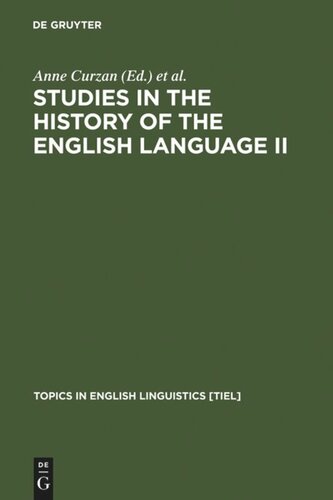

Most ebook files are in PDF format, so you can easily read them using various software such as Foxit Reader or directly on the Google Chrome browser.
Some ebook files are released by publishers in other formats such as .awz, .mobi, .epub, .fb2, etc. You may need to install specific software to read these formats on mobile/PC, such as Calibre.
Please read the tutorial at this link: https://ebookbell.com/faq
We offer FREE conversion to the popular formats you request; however, this may take some time. Therefore, right after payment, please email us, and we will try to provide the service as quickly as possible.
For some exceptional file formats or broken links (if any), please refrain from opening any disputes. Instead, email us first, and we will try to assist within a maximum of 6 hours.
EbookBell Team

4.0
76 reviewsStudies in the History of the English Language II: Unfolding Conversations contains selected papers from the SHEL-2 conference held at the University of Washington in Spring 2002. In the volume, scholars from North America and Europe address a broad spectrum of research topics in historical English linguistics, including new theories/methods such as Optimality Theory and corpus linguistics, and traditional fields such as phonology and syntax.
In each of the four sections - Philology and linguistics; Corpus- and text-based studies; Constraint-based studies; Dialectology - a key article provides the focal point for a discussion between leading scholars, who respond directly to each other's arguments within the volume. In Section 1, Donka Minkova and Lesley Milroy explore the possibilities of historical sociolinguistics as part of a discussion of the distinction between philology and linguistics. In Section 2, Susan M. Fitzmaurice and Erik Smitterberg provide new research findings on the history and usage of progressive constructions. In Section 3, Geoffrey Russom and Robert D. Fulk reanalyze the development of Middle English alliterative meter. In Section 4, Michael Montgomery, Connie Eble, and Guy Bailey interpret new historical evidence of the pen/pin merger in Southern American English. The remaining articles address equally salient problems and possibilities within the field of historical English linguistics.
The volume spans topics and time periods from Proto-Germanic sound change to twenty-first century dialect variation, and methodologies from painstaking philological work with written texts to high-speed data gathering in computerized corpora. As a whole, the volume captures an ongoing conversation at the heart of historical English linguistics: the question of evidence and historical reconstruction.